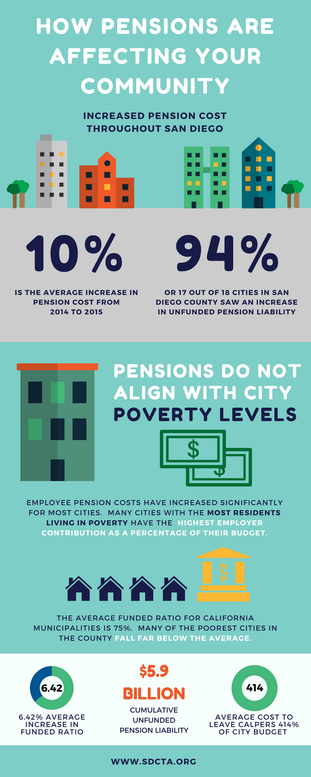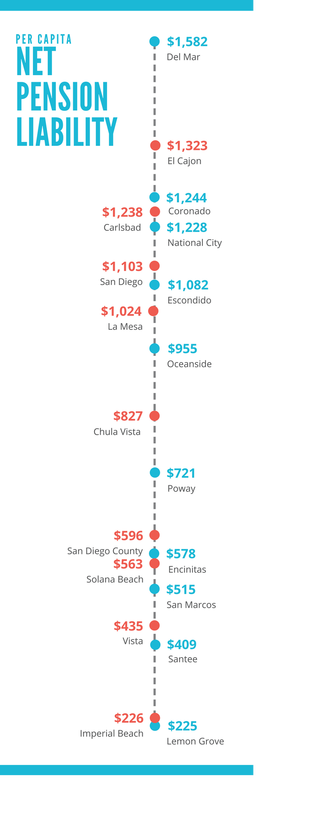|
Some San Diego‐area cities have made progress funding pensions, report finds  SAN DIEGO (March 9, 2017) — Pension obligations continue to grow among cities in San Diego County, but some cities are making significantly more progress than others in reducing their unfunded pension liability, according to a new report by the San Diego Taxpayers Educational Foundation. The annual report examines each city’s funded ratio, which compares assets to liabilities, through fiscal year 2015. While no city has reached the goal of 100 percent funded, most cities moved closer to that target. Between 2011 and 2015, the cities of San Marcos, Coronado, Carlsbad, Encinitas and Oceanside increased their funding ratio by 10 percent or more, the report found. “The San Diego Taxpayers Educational Foundation has created a thorough report on the status of the region’s public pension funds to demonstrate their effects on taxpayers,” SDCTA President & CEO Haney Hong said. Hong added: “As the report indicates, governments throughout San Diego County need to reduce unfunded pension liabilities and provide defined contribution retirement plans to lower future risks to taxpayers. High pension debt means higher annual costs, tying up tax dollars that could instead be used for police and fire protection, road repairs and other vital community services.” Of all cities in San Diego County, Coronado has the highest funded ratio – the value of a pension plan’s assets versus benefits owed – at 81.01 percent. But even at that level, each Coronado resident is on the hook for $1,244.16 of unfunded benefits. And that Coronado resident, as a resident of San Diego County, also is on the hook for an additional $595.53 of unfunded benefits for the county retirement plan. The per‐capita estimated municipal contribution to fund pensions varies greatly across the county. In Lemon Grove, for example, each resident currently pays $39.91 annually in taxes toward the city’s pension obligations, while a city of San Diego taxpayer contributes $233.17 annually. Only residents in Del Mar pay more than San Diegans, and these contributions will increase for most cities because recipients are living longer. The combination of rising pension payments and sizeable unfunded liabilities put younger taxpayers at significant risk, because if not careful, municipalities might become financially incapable of delivering services to residents in the future. Though not discussed in the report, Hong notes, “The military is implementing changes to its retirement system beginning in 2018 to introduce a defined contribution component. If the military is making this type of change for our women and men in uniform, local governments should take a hard look, too.” Hong continues, “We don’t want cities in our region to be like Detroit in the future, filing bankruptcy and not making good on promises kept.” The report offers three recommendations for how cities can reach 100 percent funded:
Contact: Tony Manolatos: tony@mnmadpr.com ABOUT
The San Diego County Taxpayers Association (@sdcta) is a non-‐profit, non-‐partisan organization, dedicated to promoting accountable, cost-‐effective and efficient government and opposing unnecessary new taxes and fees. Founded in 1945, SDCTA has spent the past 70 years saving the region’s taxpayers millions of dollars, as well as generating information to help educate the public. Founded in 1987, the San Diego Taxpayers Educational Foundation is the research arm of the San Diego County Taxpayers Association. As such, the research is released by the Taxpayers Association to bring attention to the issues that impact taxpayers and often informs the Taxpayers Association’s advocacy efforts. The Educational Foundation’s research efforts continue to spark change at government agencies throughout the county.
0 Comments
Your comment will be posted after it is approved.
Leave a Reply. |
WorkArchives
March 2020
Categories
All
|



 RSS Feed
RSS Feed